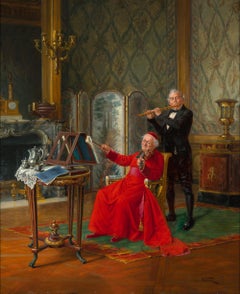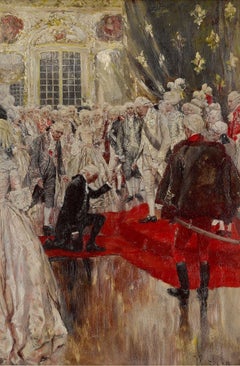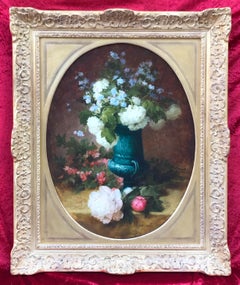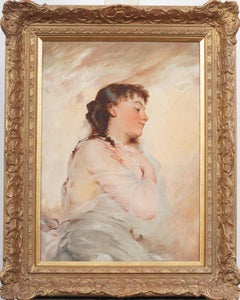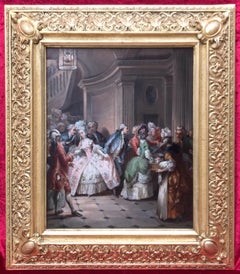Late 19th Century Interior Paintings
to
20
36
29
44
20
22
Overall Width
to
Overall Height
to
89
393
1,961
5,421
33
44
60
99
78
123
146
146
126
108
46
20
3
2
1
1
1
90
60
1
104
76
43
35
22
10
10
9
8
8
7
7
6
6
5
5
5
5
4
4
149
141
69
68
17
2
2
1
1
1
116
7
99
52
Period: Late 19th Century
The Musician
Located in New Orleans, LA
Alfred Weber
1859-1922 I Swiss
The Musician
Signed “Alfred Weber” (lower left)
Oil on panel
This work by Swiss ecclesiastical genre painter Alfred Weber, best known for his humorous and meticulously detailed paintings, features a cardinal enjoying his leisure time. Weber's talent for rendering opulent interiors and his keen sense of comic narrative are evident in this painting. The cardinal, looking blissfully content, sits in his lavish living space playing the violin, accompanied by a flutist.
Alfred Charles Weber...
Category
Academic Late 19th Century Interior Paintings
Materials
Oil, Panel
King Louis
By Howard Pyle
Located in Fort Washington, PA
Medium: Oil on Panel
Signature: Signed "H. Pyle" Lower Right and Inscribed Indistinctly On the Reverse
"At the same time he extended toward King Louis the ...
Category
Late 19th Century Interior Paintings
Materials
Oil, Panel
Flower Arrangement - Original 19th Century Painting
By Achille Théodore Cesbron
Located in Saint-Ouen, FR
Achille Théodore CESBRON (1849-1915)
Flower Arrangement
Oil on oval canvas signed low right
Framed by Gault (Paris - Fbg St Honoré)
Dim canvas : 63 X 48 cm
Dim frame : 79 X 64 cm
Achille Théodore CESBRON (1849-1915)
French school 19th-20th century
Born the 5th of November 1849 in Oran (Algeria). Dead the 4th of January 1915.
Painter of genre scene, portraits, still life, flowers, pastel.
Pupil of Bonnat and Cormon, he regularly exhibited at the « Salon des Artistes Français », whose he became shareholder in 1883, getting several rewards and medals from 1882 to 1886.
He has got the Marie...
Category
Academic Late 19th Century Interior Paintings
Materials
Oil
19th Century European Realist Art Nouveau Young Woman Portrait Framed Painting
Located in Buffalo, NY
Antique European realist portrait oil painting. Oil on canvas. Framed. In excellent original condition. Handsomely framed in a wood molding. Excellent condition, ready to hang ...
Category
Realist Late 19th Century Interior Paintings
Materials
Oil, Board
"A Quiet Afternoon" Enoch Wood Perry, Genre Scene Mother and Child Interior
By Enoch Wood Perry Jr.
Located in New York, NY
Enoch Wood Perry, Jr. (1831 - 1915)
A Quiet Afternoon, 1876
Oil on canvas
15 1/4 x 21 inches
Signed and dated lower right
Born in 1831 in Boston, Enoch Wood Perry, Jr, is internati...
Category
Hudson River School Late 19th Century Interior Paintings
Materials
Canvas, Oil
A Party To The Castle in 18th Century
Located in Saint-Ouen, FR
A Party To The Castle in the 18th Century
Oil on canvas with a signature G.Weiss low left
Old frame regilded
Dim canvas : 46 X 38 cm
Dim frame : 66 X 58 cm
Category
Academic Late 19th Century Interior Paintings
Materials
Oil
Interior of a Japanese House
Located in New York, NY
Harry Humphrey Moore led a cosmopolitan lifestyle, dividing his time between Europe, New York City, and California. This globe-trotting painter was also active in Morocco, and most importantly, he was among the first generation of American artists to live and work in Japan, where he depicted temples, tombs, gardens, merchants, children, and Geisha girls. Praised by fellow painters such as Thomas Eakins, John Singer Sargent, and Jean-Léon Gérôme, Moore’s fame was attributed to his exotic subject matter, as well as to the “brilliant coloring, delicate brush work [sic] and the always present depth of feeling” that characterized his work (Eugene A. Hajdel, Harry H. Moore, American 19th Century: Collection of Information on Harry Humphrey Moore, 19th Century Artist, Based on His Scrap Book and Other Data [Jersey City, New Jersey: privately published, 1950], p. 8).
Born in New York City, Moore was the son of Captain George Humphrey, an affluent shipbuilder, and a descendant of the English painter, Ozias Humphrey (1742–1810). He became deaf at age three, and later went to special schools where he learned lip-reading and sign language. After developing an interest in art as a young boy, Moore studied painting with the portraitist Samuel Waugh in Philadelphia, where he met and became friendly with Eakins. He also received instruction from the painter Louis Bail in New Haven, Connecticut. In 1864, Moore attended classes at the Mark Hopkins Institute in San Francisco, and until 1907, he would visit the “City by the Bay” regularly.
In 1865, Moore went to Europe, spending time in Munich before traveling to Paris, where, in October 1866, he resumed his formal training in Gérôme’s atelier, drawing inspiration from his teacher’s emphasis on authentic detail and his taste for picturesque genre subjects. There, Moore worked alongside Eakins, who had mastered sign language in order to communicate with his friend. In March 1867, Moore enrolled at the prestigious École des Beaux-Arts, honing his drawing skills under the tutelage of Adolphe Yvon, among other leading French painters.
In December 1869, Moore traveled around Spain with Eakins and the Philadelphia engraver, William Sartain. In 1870, he went to Madrid, where he met the Spanish painters Mariano Fortuny and Martin Rico y Ortega. When Eakins and Sartain returned to Paris, Moore remained in Spain, painting depictions of Moorish life in cities such as Segovia and Granada and fraternizing with upper-crust society. In 1872, he married Isabella de Cistue, the well-connected daughter of Colonel Cistue of Saragossa, who was related to the Queen of Spain. For the next two-and-a-half years, the couple lived in Morocco, where Moore painted portraits, interiors, and streetscapes, often accompanied by an armed guard (courtesy of the Grand Sharif) when painting outdoors. (For this aspect of Moore’s oeuvre, see Gerald M. Ackerman, American Orientalists [Courbevoie, France: ACR Édition, 1994], pp. 135–39.) In 1873, he went to Rome, spending two years studying with Fortuny, whose lively technique, bright palette, and penchant for small-format genre scenes made a lasting impression on him. By this point in his career, Moore had emerged as a “rapid workman” who could “finish a picture of given size and containing a given subject quicker than most painters whose style is more simple and less exacting” (New York Times, as quoted in Hajdel, p. 23).
In 1874, Moore settled in New York City, maintaining a studio on East 14th Street, where he would remain until 1880. During these years, he participated intermittently in the annuals of the National Academy of Design in New York and the Pennsylvania Academy of the Fine Arts in Philadelphia, exhibiting Moorish subjects and views of Spain. A well-known figure in Bay Area art circles, Moore had a one-man show at the Snow & May Gallery in San Francisco in 1877, and a solo exhibition at the Bohemian Club, also in San Francisco, in 1880. Indeed, Moore fraternized with many members of the city’s cultural elite, including Katherine Birdsall Johnson (1834–1893), a philanthropist and art collector who owned The Captive (current location unknown), one of his Orientalist subjects. (Johnson’s ownership of The Captive was reported in L. K., “A Popular Paris Artist,” New York Times, July 23, 1893.) According to one contemporary account, Johnson invited Moore and his wife to accompany her on a trip to Japan in 1880 and they readily accepted. (For Johnson’s connection to Moore’s visit to Japan, see Emma Willard and Her Pupils; or, Fifty Years of Troy Female Seminary [New York: Mrs. Russell Sage, 1898]. Johnson’s bond with the Moores was obviously strong, evidenced by the fact that she left them $25,000.00 in her will, which was published in the San Francisco Call on December 10, 1893.) That Moore would be receptive to making the arduous voyage across the Pacific is understandable in view of his penchant for foreign motifs. Having opened its doors to trade with the West in 1854, and in the wake of Japan’s presence at the Philadelphia Centennial Exposition of 1876, American artists were becoming increasingly fascinated by what one commentator referred to as that “ideal dreamland of the poet” (L. K., “A Popular Paris Artist”).
Moore, who was in Japan during 1880–81, became one of the first American artists to travel to the “land of the rising sun,” preceded only by the illustrator, William Heime, who went there in 1851 in conjunction with the Japanese expedition of Commodore Matthew C. Perry; Edward Kern, a topographical artist and explorer who mapped the Japanese coast in 1855; and the Boston landscapist, Winckleworth Allan Gay, a resident of Japan from 1877 to 1880. More specifically, as William H. Gerdts has pointed out, Moore was the “first American painter to seriously address the appearance and mores of the Japanese people” (William H. Gerdts, American Artists in Japan, 1859–1925, exhib. cat. [New York: Hollis Taggart Galleries, 1996], p. 5).
During his sojourn in Nippon (which means, “The Land of the Rising Sun”), Moore spent time in locales such as Tokyo, Yokohama, Kyoto, Nikko, and Osaka, carefully observing the local citizenry, their manners and mode of dress, and the country’s distinctive architecture. Working on easily portable panels, he created about sixty scenes of daily life, among them this depiction of an interior of a dwelling. The location of the view is unknown, but the presence of a rustic rail fence demarcating a yard bordering a distant house flanked by tall trees, shrubs and some blossoming fruit trees, suggests that the work likely portrays a building in a city suburb or a small village.
In his book, Japanese Homes and Their Surroundings, Edward S. Morse (an American zoologist, orientalist, and “japanophile” who taught at Tokyo Imperial University from 1877 to 1879, and visited Japan again in 1891 and 1882) noted the “openness and accessibility of the Japanese house...
Category
Late 19th Century Interior Paintings
Materials
Oil, Wood Panel
Watercolour painting of Russian peasants feasting by Teikh
Located in London, GB
Watercolour painting of Russian peasants feasting by Teikh
Russian, 1872
Frame: Height 92cm, width 122cm, depth 6cm
Sheet: Height 76cm, width 107cm
This fine watercolour painting is...
Category
Late 19th Century Interior Paintings
Materials
Watercolor
Antique American Oil Painting Strawberries in a Basket Late 19th C
Located in Douglas Manor, NY
5158 Antique American oil painting straberries in a basket interior scene
Late 19th century
Category
Late 19th Century Interior Paintings
Materials
Oil
The Palace Courtyard
Located in London, GB
Georges-Antoine Rochegrosse
French 1859 - 1938
The Palace Courtyard
Oil on canvas, signed lower left
Image size: 26 ¾ x 19 ¾ inches (68 x 50 cm)
Ornate orientalist gilt frame (Image ...
Category
Late 19th Century Interior Paintings
Materials
Oil
Theater Interior Design
Located in London, GB
SERGE FERAT 1881-1958
(Le Comte Sergueï Yastrebzov) Moscow 1881-1958 Paris (Russian/French)
Title: Theater Interior Design
Technique: Original Signed Gouache Painting on paper
siz...
Category
Cubist Late 19th Century Interior Paintings
Materials
Gouache
The Letter By Georges Croegaert
Located in New Orleans, LA
Georges Croegaert
1848-1923 Belgian
The Letter
Signed "Georges Croegaert Paris" (lower right)
Oil on panel
A cardinal pauses while composing a letter in this oil on panel by Belg...
Category
Academic Late 19th Century Interior Paintings
Materials
Oil, Panel
"Coro de monaguillos ensayando", 19th Century Oil on Wood Panel by José Gallegos
By José Gallegos y Arnosa
Located in Madrid, ES
JOSÉ GALLEGOS Y ARNOSA
Spanish, 1857 - 1917
CORO DE MONAGUILLOS ENSAYANDO
signed, located and dated "JGallegos / Roma 1883" (lower right)
oil on...
Category
Realist Late 19th Century Interior Paintings
Materials
Oil, Wood Panel
Pretending (The Great Performance)
Located in Mc Lean, VA
Signed and dated '1890' lower right
Category
Academic Late 19th Century Interior Paintings
Materials
Oil
"Playing hide and seek", 19th Century Oil on Panel by Vicente Palmaroli, Spanish
Located in Madrid, ES
VICNTE PALMAROLI y GONZÁLEZ
Spanish, 1834 - 1896
PLAYING HIDE AND SEEK
signed "V. Palmaroli" (lower right)
oil on mahogany panel
17-3/4 x 13-1/2 inches (45 X 34 cm.)
framed: 25-1/4 X 21-1/4 inches (64 X 53.7 cm.)
PROVENANCE
Leslie Hindman Inc., Auctionners
Private Collector, Madrid
Oil on table by Vicente Palmaroli...
Category
Romantic Late 19th Century Interior Paintings
Materials
Oil, Wood Panel
CHRISTIAN ROULLIER Beautiful Woman Arranges Flowers Atrium Greenhouse PARIS 1884
By Christian Henri Roullier
Located in Rancho Santa Fe, CA
Christian-Henri Roullier was born in Lyon, France, in 1845, and was an infant when his parents arrived in gold-rush San Francisco. After much difficulty, Roullier senior found employment at the White House, a pioneer department store owned by a popular and successful French businessman, Raphael Weill. From then, the Roulliers' life took a prosperous turn. Christian-Henri resided with his family in San Francisco at the beginning of his career. During the Franco-Prussian War he was listed, with other members of the city's French community, as a local subscriber to a French patriotic fund. He subsequently traveled to Paris to study painting with Jean-Leon Gerome the leading teacher of the day. He also studied sculpture with W. E. Fremiet and explored both media throughout his life.
A successful artist, Roullier exhibited widely in France. His work was included in most Paris Salon exhibits between 1878 and 1914. He exhibited at the San Francisco Art Association and the Mechanics' Institute of San Francisco in 1883, suggesting that he had returned to San Francisco, perhaps working with Jules Tavernier, whom he depicted in buckskin and knee-high boots in an oil entitled Tavernier Painting. Roullier probably joined the gregarious Tavernier in Monterey as well. Among his portraits, he executed two of Josiah Stanford, now in the collection at the Cantor Center for Visual Arts at Stanford University.
When in France, Roullier and his sister Blanche spent half of their time in Paris, the remainder at a beautiful property the family bought in the small town of Saint-Nizier sous Charlieu, some ten miles from Roanne. Blanche became a successful pastellist who also exhibited at the French salons and received several awards. Like his friend and fellow-painter Armand Charnay, Roullier painted rustic, local scenes of his native region, except for a few canvases of Tunisia done in colors reminiscent of his California work. He died in Paris on July 25, 1926. A retrospective exhibit of his work was held at the 1926 Paris Winter...
Category
French School Late 19th Century Interior Paintings
Materials
Oil, Canvas
Antique English Oil Painting Interior Scene "The Chess Match" 1890's
Located in Douglas Manor, NY
1666 Antique interior scene oil painting The Chess Match circa 1890's
Image size 19.5x 13.5"
Category
Late 19th Century Interior Paintings
Materials
Canvas, Oil
Portrait at the Painter's workshop
Located in Saint-Ouen, FR
Francesco Brunery (1849–1926)
Portrait at the Artist's Workshop
Oil on wood panel
Old frame gilded with leaves
Dim panel : 30 X 24 cm
Dim frame : 54 X 46 cm
Francesco Brunery (1849...
Category
Academic Late 19th Century Interior Paintings
Materials
Oil
Interior of Knole House, 19th Century Oil on Canvas Painting
Located in London, GB
This grand scene depicts the interior of Knole House, a country house and former archbishops palace. Situated within the 1,000 acre Knole Park the house ranks in the top five of England's largest houses occupying a total of four acres.
The majority of the canvas is given to a well furnished drawing room resplendent with various paintings, tapestries and furniture. To this day Knole House has one of the finest collections of 17th century English upholstered furniture in the world. Much of it was made for the royal palaces of the ruling Stuart dynasty and is of the highest quality. It is likely that the chair and footstools seen her originally came to Knole house as part of the vast collection put together by Charles, 6th Earl of Dorset.
This work has incredible intricate detail in all aspects of the space including the depiction of flowers in vases, a bird in a cage and adorned trinkets. On the armchair sits an English guittar, popular in Victorian Britain. The instrument is recognisable for its pear-shaped body, flat base and rather short neck.
A dog stands before an opened door leading further into the house. In the distance we are given just a glimpse of a lady and gentleman conversing at the window. From here a lovely flow of daylight floods into the rest of the scene making the whole work bright and airy. In the foreground on the windowsill is a music book with pages open and an untouched peach. This perhaps signifies the sudden rush of the young woman away from her resting place to meet the unexpected suitor outside.
The Artist
John Watkins Chapman...
Category
Victorian Late 19th Century Interior Paintings
Materials
Canvas, Oil
"The Mandolin Serenade", 19th Century Watercolour on Cardboard by Giménez Martín
Located in Madrid, ES
JUAN GIMÉNEZ MARTÍN
Spanish 1855 - 1901
THE MANDOLIN SERENADE
signed & located "Gimenez-Martin, Roma" lower left
watercolour on cardboard
21-1/4 x ...
Category
Realist Late 19th Century Interior Paintings
Materials
Watercolor, Cardboard
Edgard CUGNOTET - Painting 19th Century - Portrait of Two Children
By Edouard Ferdinand Ludovic Cugnotet
Located in Saint-Ouen, FR
CUGNOTET Edgard (19th Century)
Portrait of two Children
Oil on canvas signed low left and dated 1884
Frame gilded with leaves
Dim canvas : 138 X 100 cm
Dim Frame : 162 X 122 cm
CUGNOTET Edgard Ferdinand Ludovic (19th Century)
French painter 19th Century born in Dijon
Figures, Portraits, Landscapes
He was taught by François Édouard PICOT (1786-1868) royal Academy of Anvers.
He exhibited at the Salon de Paris between 1868 and 1884.
Museum : Langres « the hurdy gurdy...
Category
Academic Late 19th Century Interior Paintings
Materials
Oil
"Lady in yellow", 19th Century oil on panel by Rogelio de Egusquiza y Barrena
Located in Madrid, ES
ROGELIO DE EGUSQUIZA Y BARRENA
LADY IN YELLOW
signed "R. Egusquiza" (lower right)
oil on panel
28-5/8 X 20-3/4 inches (72.5 X 52.7 cm.)
framed: 32-5/8 X 24-3/4 inches (82.5 X 62.5 cm.)
Rogelio de Egusquiza y Barrena (1845 – 10 February 1915) was a Spanish painter, known for his friendship with the German composer Richard Wagner, whose works he helped make familiar in Spain
He was born in El Astillero, into a well-to-do family. He studied in Madrid and with Léon Bonnat at the École des Beaux-Arts in Paris. In 1868, after travelling and participating several times in the National Exhibition of Fine Arts, he returned to Paris and settled there. At first, he painted historical scenes, but later turned to genre scenes and portraits in the Academic style.
Following the death of Marià Fortuny, he moved to Rome at the invitation of the Madrazos, Raimundo and Ricardo, taking Fortuny's place at their studio through 1875 and attending classes at the Spanish Academy in Rome.
He heard Wagner's music for the first time in 1876, after returning to Paris. Three years later, he travelled to Munich to hear a performance of The Ring of the Nibelungen. His enthusiasm for what he heard led him to go to Bayreuth, where he introduced himself to Wagner and became his friend. In the following years, he and Wagner got together again several times; in Venice (1880), Berlín (1881) and Bayreuth (1882); where he was a guest at the premiere of Parsifal.
After his first meeting with Wagner, he decided to devote his career to doing works on Wagnerian themes; mostly portraits of the characters rather than specific scenes. During his visits to Germany, he also created portraits of Arthur Schopenhauer (posthumous) and King Ludwig II...
Category
Realist Late 19th Century Interior Paintings
Materials
Oil, Panel
Lucrèce Borgia
Located in Paris, FR
Antoine Georges Rochegrosse
1859-1938
Lucrèce Borgia, circa 1880
Oil on canvas
Signed lower right
Canvas: 36 5/8" high x 29 1/8" wide
Frame: 50 3/8" high x 40 1/8" wide
Georges...
Category
Academic Late 19th Century Interior Paintings
Materials
Canvas, Oil
"The Florence Sisters", 19th Century Oil on Canvas, Spanish Artist José Villegas
Located in Madrid, ES
JOSÉ VILLEGAS Y CORDERO
Spanish 1844 - 1921
"The Florence Sisters"
signed "Villegas" (lower left)
oil on canvas
33-1/2 X 40-1/2 inches (84.5 X 102.5 cm.)
PROVENANCE
Private Collector, Seville, Spain
José Villegas Cordero (Seville, August 26, 1844-Madrid, November 9, 1921) was a Spanish painter. He directed the Prado Museum between 1901 and 1918.
Biography
He was the brother of the painter Ricardo Villegas Cordero. He began his apprenticeship very young with José María Romero, with whom he remained for two years until entering the School of Fine Arts in Seville, where he was under the tutelage of Eduardo Cano.
In 1860, when he was only 16 years old, he sold his work Little Philosophy for 2,000 reais at the Seville Exhibition. In 1867 he traveled to Madrid, where he entered Federico Madrazo's studio. There he established friendship with painters Eduardo Rosales and Fortuny.
He went regularly to the Prado where he copied Velázquez, from whom he acquired spontaneity and the use of color for his technique.
Finally, and out of admiration for Fortuny's orientalist painting, he returned to Seville and organized an excursion to Morocco.
At the end of 1868 he decided to travel to Rome accompanied by the painters Rafael Peralta and Luis Jiménez Aranda...
Category
Realist Late 19th Century Interior Paintings
Materials
Canvas, Oil
Reception at the Salon
Located in Saint-Ouen, FR
STEVENS Agapit (1848 – 1924)
Reception at the Salon
Oil on wood signed low left
New Golden Frame
Dim wood panel : 24 X 39 cm
Dim Frame : 49 X 63 cm
STEVENS Agapit (1848 – 1924)
Be...
Category
Academic Late 19th Century Interior Paintings
Materials
Oil
A Musician oil painting by Frederick E. Wright
Located in Hudson, NY
This work of a young musician by Frederick E. Wright is set in an exceptional original Doll & Richards, Boston, frame. The framed dimensions are 16' x 13 1/3" x 1". A hand-written la...
Category
Abstract Impressionist Late 19th Century Interior Paintings
Materials
Oil, Panel
Table Settings With Orchids, Painting 19th Century
Located in Saint-Ouen, FR
DESCHIENS – ASTRUC (1861)
Table settings with Orchids
Oil on canvas signed down right
Frame gilded with gold leaves
Dim canvas : 82 X 116 cm
Dim Frame : 107 X 141 cm
DESCHIENS – ASTRUC Pauline Hélène (1861-NC)
French school 19th - 20th century
Born the 25th of August 1861 in Angers
Painter of flowers and marines. Pupil of Pierre Bourgogne...
Category
Academic Late 19th Century Interior Paintings
Materials
Oil
Basket of pansies Flowers - painting 19th century
Located in Saint-Ouen, FR
BIVA Paul (1851 - 1900)
Basket of Pansies
Oil on canvas signed low left
Framed by Gault (Paris)
Dim canvas : 60 X 80 cm
Dim frame : 80 X 100 cm
BIVA Paul (1851 - 1900)
French Pain...
Category
Academic Late 19th Century Interior Paintings
Materials
Oil
Interior Scene of a Woman in Black Gazing Out a Window
By William Verplank Birney
Located in Fort Washington, PA
An elegantly dressed woman sits gazing out of a window with a book on her lap. A fine example of the type of contemplative genre scenes for which Birney was well-known.
William Verp...
Category
Late 19th Century Interior Paintings
Materials
Canvas, Oil
Antique Gouache Painting Artist Studio Interior Painting 1870
Located in Douglas Manor, NY
3929 Antique interior painting of an artist studio works on artist board
Set in a period walnut frame image size 19.5x13.5"
Category
Late 19th Century Interior Paintings
Materials
Watercolor, Gouache
Antique English Oil Painting Interior Scene "The Chess Match" 1890's
Located in Douglas Manor, NY
1666 Antique interior scene oil painting The Chess Match circa 1890's
Image size 19.5x 13.5"
Category
Late 19th Century Interior Paintings
Materials
Oil, Canvas
Dario Santini (Italian, 1874-1924) Rug Merchant watercolor .
Located in New York, NY
Dario Santini, an Italian painter born in Ancona in 1874, largely focused on subjects of the west in his practice, making an orientalist painting by him rather rare. Skillfully rendered in watercolor, a young man reclines in a stately home, fanning himself with a peacock feather fan...
Category
Italian School Late 19th Century Interior Paintings
Materials
Watercolor
The Question to be Answered
Located in Saratoga Springs, NY
A beautiful 19th Century Northern European School genre, as a young gentleman poses a question to the young lady, as the father looks on. All is original and with the period frame. A...
Category
Realist Late 19th Century Interior Paintings
Materials
Canvas, Oil
Russian watercolour of the coronation of a Tsar
Located in London, GB
Russian watercolour of the coronation of a Tsar
Russian, late 19th Century
Frame: Height 39cm, width 30cm, depth 0.5cm
Sheet: Height 36cm, width 2...
Category
Late 19th Century Interior Paintings
Materials
Watercolor
Austrian genre painting of children in a classroom by Rudolf Geyling
By Rudolf Geyling
Located in London, GB
Austrian genre painting of children in a classroom by Rudolf Geyling
Austrian, late 19th Century
Frame: Height 94cm, width 126cm, depth 8cm
Canvas: Height 75cm, width 101cm, depth 2c...
Category
Late 19th Century Interior Paintings
Materials
Canvas, Oil
